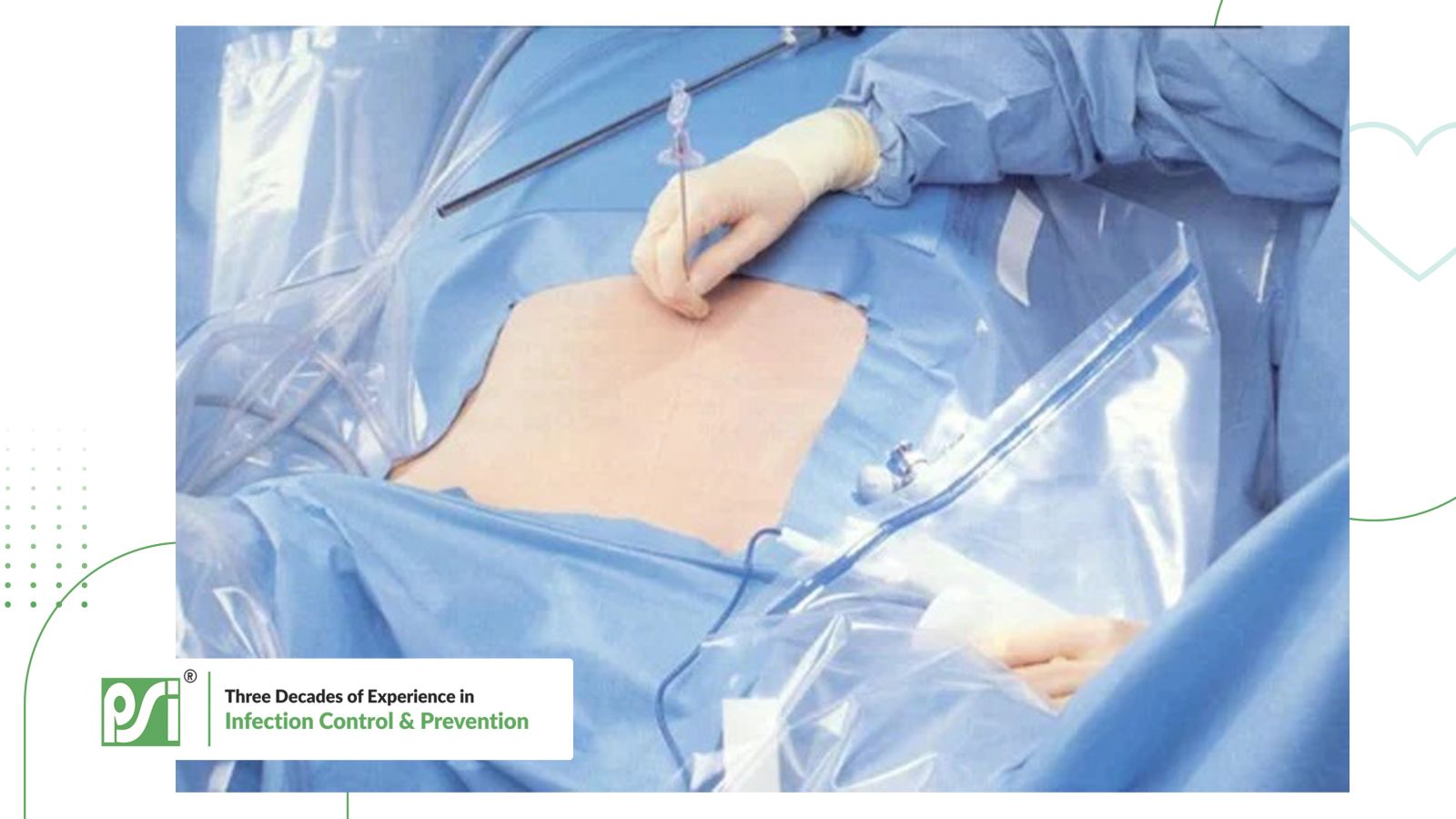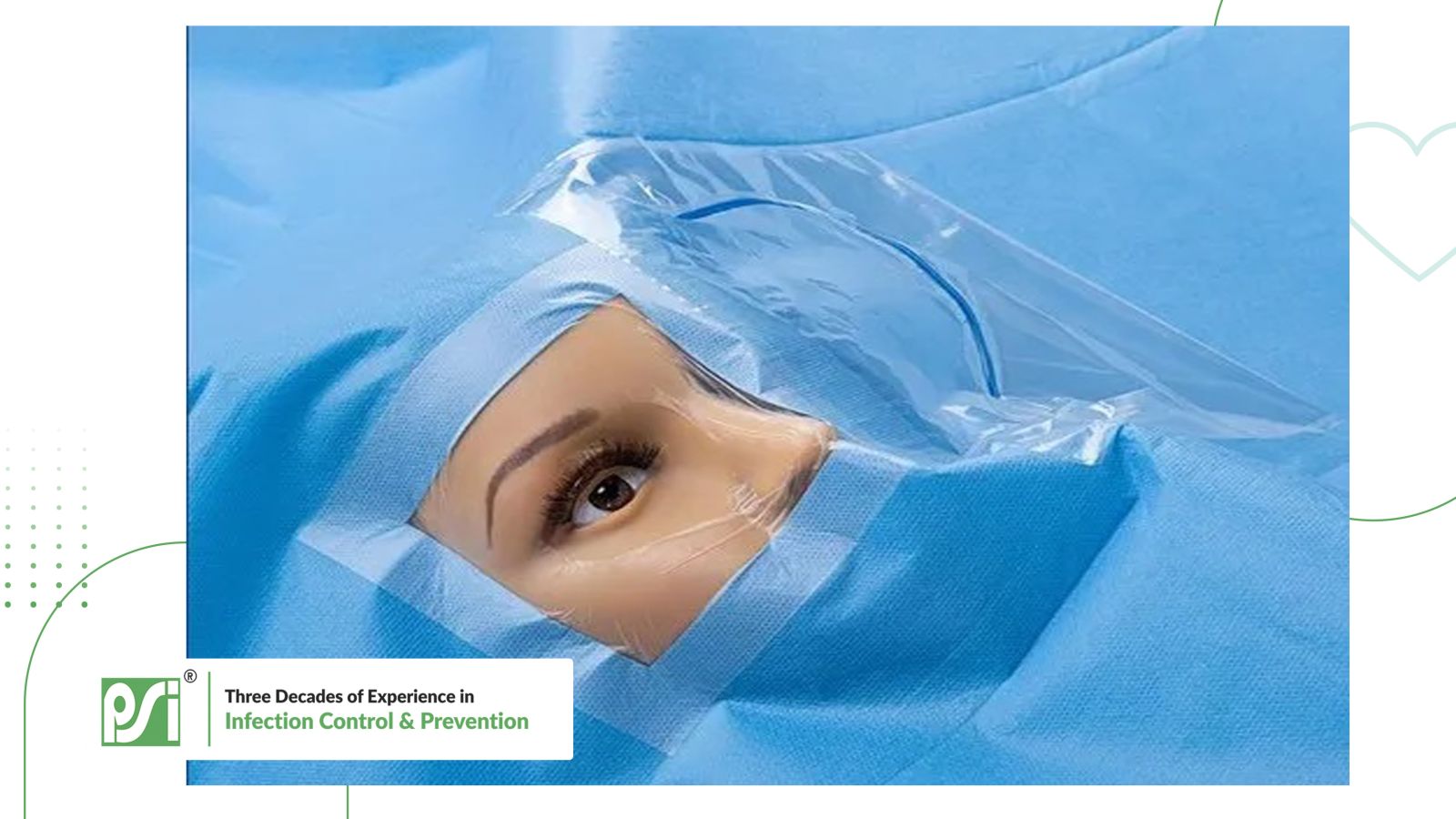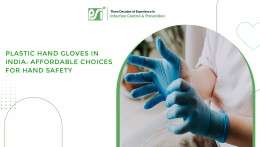One of the best Surgical Disposables company. I am dealing with them for the past 5 years,
their products are world-class. Their approach to trade is professional. All the best wishes to
them.
Unveiling the Advantages of Disposable Drapes: Balancing Medical Efficiency and Environmental Impact
- By: Plasti Surge Industries

Disposable drapes play a pivotal role in maintaining the highest standards of hygiene and sterility within medical procedures. These single-use protective covers are designed to create a barrier, preventing cross-contamination and ensuring a sterile environment during surgeries, examinations, and various medical interventions. The significance of disposable drapes lies in their ability to safeguard both patients and healthcare professionals from potential infections. By providing an impermeable barrier, these drapes contribute to a controlled and sterile workspace, crucial for successful medical outcomes. This blog will delve into the diverse advantages of disposable drapes, addressing their role in enhancing medical efficiency while also exploring the environmental considerations associated with their use. Join us on this exploration of the intricate balance between medical efficiency and environmental impact in the realm of disposable drapes.
Benefits of Disposable Drapes
 The benefits of using disposable drapes in medical procedures extend beyond their primary function as protective covers. One of the key advantages lies in the significant reduction of cross-contamination risks. Unlike reusable drapes, which may harbor residual pathogens despite thorough cleaning, disposable drapes offer a fresh, sterile surface for each procedure. This inherent hygiene advantage contributes to maintaining aseptic conditions in the operating room, ultimately minimizing the potential for infections.
The benefits of using disposable drapes in medical procedures extend beyond their primary function as protective covers. One of the key advantages lies in the significant reduction of cross-contamination risks. Unlike reusable drapes, which may harbor residual pathogens despite thorough cleaning, disposable drapes offer a fresh, sterile surface for each procedure. This inherent hygiene advantage contributes to maintaining aseptic conditions in the operating room, ultimately minimizing the potential for infections.
In addition to preventing cross-contamination, the convenience of disposal is a noteworthy benefit. After a single use, disposable drapes can be easily discarded, eliminating the need for extensive cleaning processes associated with reusable alternatives. This not only streamlines the workflow in medical settings but also reduces the overall environmental burden of water and energy consumption related to laundering reusable drapes. The amalgamation of hygiene advantages and disposal convenience makes disposable drapes a valuable asset in upholding the highest standards of patient care and medical efficiency.
Environmental Impact of Disposable Drapes
|
CONCERNS |
ECO-FRIENDLY ALTERNATIVES & ADVANCEMENTS |
|
Environmental Impact |
Disposable drapes contribute to waste. |
|
Material Composition |
Explore biodegradable materials for eco-friendly options. |
|
Disposal Methods |
Proper disposal practices to mitigate environmental impact. |
|
Recycling Initiatives |
Support recycling programs for disposable drapes. |
|
Advancements |
Explore innovative materials with minimal environmental impact. |
Addressing concerns about the environmental impact of disposable drapes is crucial for promoting sustainable healthcare practices. The table above outlines key concerns and suggests eco-friendly alternatives and advancements in material to mitigate these issues. Exploring biodegradable materials, implementing proper disposal methods, and supporting recycling initiatives are essential steps toward balancing medical efficiency with environmental responsibility. Additionally, staying informed about advancements in materials that minimize environmental impact allows healthcare professionals to make conscious choices in selecting disposable drapes.
Comparative Analysis with Reusable Drapes
Disposable drapes offer several advantages over reusable options in medical procedures. Here's a breakdown of the pros and cons, highlighting the benefits of using disposable drapes:
Pros of Disposable Drapes:
- Sterility: Disposable drapes come in individually packaged sterile units, reducing the risk of infections.
- Convenience: They eliminate the need for washing, sterilizing, and storing, saving time and resources.
- Cost-Effective: While initial costs may be higher, disposable drapes can be more cost-effective in the long run due to reduced labor and maintenance expenses.
- Single-Use Efficiency: Each drape is designed for single-use, ensuring optimal efficiency and preventing cross-contamination.
Cons of Reusable Drapes:
- Sterility Challenges: Reusable drapes may face challenges in maintaining consistent sterility after multiple uses.
- Labor-Intensive: Cleaning and sterilizing reusable drapes can be labor-intensive and may require additional resources.
- Storage Space: Reusable drapes demand storage space for washing and sterilization between uses.
In conclusion, the benefits of disposable drapes, including sterility, convenience, and cost-effectiveness, make them a preferred choice in medical procedures. The single-use efficiency significantly contributes to maintaining a sterile environment and ensuring patient safety.
Compliance with Medical Standards
Disposable drapes play a crucial role in adhering to stringent medical regulatory standards, ensuring the maintenance of a safe and compliant medical environment. These drapes are designed and manufactured in accordance with established guidelines and specifications set by health regulatory authorities. The following points highlight their compliance:
- Stringent Manufacturing Processes: Disposable drapes undergo rigorous manufacturing processes that meet or exceed industry standards. These processes ensure the production of sterile and high-quality products.
- Material Selection: The materials used in disposable drapes are carefully chosen to meet medical standards. They are often made from hypoallergenic and non-reactive materials to minimize the risk of adverse reactions.
- Individually Packaged: Disposable drapes are typically individually packaged in sterile conditions. This packaging ensures that each drape maintains its sterility until the moment it is used in a medical procedure.
- Documentation and Certification: Manufacturers provide documentation and certification attesting to the compliance of disposable drapes with relevant medical standards. This transparency enables healthcare facilities to verify the quality and regulatory adherence of the products.
In conclusion, disposable drapes not only offer medical efficiency but also contribute to maintaining a safe and compliant medical environment by meeting the rigorous standards set by regulatory bodies. Healthcare professionals can trust these products to uphold the highest quality and safety standards in medical procedures.
Innovations in Disposable Drape Technology
In the realm of disposable drapes, ongoing advancements focus on enhancing durability and performance while minimizing the environmental impact. Innovations in materials and manufacturing processes are key contributors to improved medical efficiency:
- Enhanced Durability: Modern disposable drapes feature advancements in materials that enhance their durability without compromising sterility. This ensures that they maintain structural integrity throughout medical procedures.
- Advanced Barrier Properties: Innovations in barrier materials contribute to better protection against contaminants, offering an added layer of defense during surgeries and medical interventions. This not only improves the efficacy of disposable drapes but also enhances patient safety.
- Sustainable Materials: Manufacturers are increasingly exploring sustainable materials for disposable drapes, addressing concerns about environmental impact. This includes the use of eco-friendly alternatives and recyclable materials, aligning with broader efforts towards sustainability in healthcare.
These advancements underscore a commitment to both medical efficiency and environmental responsibility. Healthcare professionals can expect disposable drapes to continually evolve, providing enhanced performance while minimizing their ecological footprint.
Choosing the Right Disposable Drapes
 Selecting appropriate disposable drapes is crucial for maintaining a sterile and efficient medical environment. Healthcare professionals should consider the following guidelines when choosing drapes tailored to specific medical procedures:
Selecting appropriate disposable drapes is crucial for maintaining a sterile and efficient medical environment. Healthcare professionals should consider the following guidelines when choosing drapes tailored to specific medical procedures:
1. Procedure-specific Design: Different medical procedures require specialized drapes designed to meet specific needs. Ensure that the selected drapes are suitable for the intended procedure, providing optimal coverage and access for healthcare practitioners.
2. Sterility Assurance: Prioritize disposable drapes with advanced sterilization methods to guarantee aseptic conditions during surgery or medical interventions. Look for drapes individually packaged and labeled to indicate their sterility status.
3. Barrier Properties: Evaluate the barrier properties of the drapes, considering factors such as fluid resistance, microbial barrier, and breathability. The drapes should offer an effective shield against contaminants while allowing sufficient airflow to maintain a comfortable environment.
4. Adhesive and Fenestration: Assess the adhesive quality for secure placement, ensuring that drapes adhere properly without compromising sterility. Additionally, consider the presence and design of fenestrations to provide access to the surgical site while maintaining coverage in critical areas.
5. Size and Dimensions: Choose drapes of appropriate size and dimensions for the specific surgical or medical procedure. Proper coverage and fit contribute to the overall effectiveness of the drapes in preventing cross-contamination.
6. Compliance with Standards: Verify that the selected disposable drapes comply with relevant medical standards and regulations. Compliance ensures that the drapes meet the necessary quality and safety requirements for medical use.
By adhering to these guidelines, healthcare professionals can confidently select disposable drapes that align with the unique requirements of each medical procedure, promoting optimal sterility and efficiency in healthcare settings.
Environmental Sustainability Practices
Responsible disposal practices and sustainable initiatives in healthcare settings play a crucial role in minimizing the environmental impact of disposable drapes. To promote sustainability, healthcare facilities can implement the following initiatives:
1. Recycling Programs: Establish dedicated recycling programs for disposable drapes made from recyclable materials. Collaborate with waste management services to ensure proper collection, segregation, and recycling of these materials, contributing to reduced waste and resource conservation.
2. Biodegradable Materials: Explore the use of biodegradable materials for disposable drapes. Biodegradable options break down naturally over time, reducing the long-term environmental impact and fostering eco-friendly practices in healthcare waste management.
3. Waste-to-Energy Conversion: Investigate waste-to-energy technologies that can convert medical waste, including disposable drapes, into energy. This approach not only minimizes landfill contributions but also harnesses energy from the waste, aligning with sustainable and efficient resource utilization.
4. Supplier Collaboration: Collaborate with suppliers to source disposable drapes from manufacturers committed to sustainable practices. Select suppliers who prioritize eco-friendly materials, production processes, and packaging, contributing to the overall sustainability of healthcare procurement.
5. Education and Training: Provide education and training programs for healthcare staff on responsible disposal practices. Ensure that staff members are aware of the environmental impact of medical waste, including disposable drapes, and are equipped with the knowledge to make sustainable choices in their daily operations.
6. Continuous Improvement: Implement a continuous improvement framework to regularly assess and enhance sustainability initiatives. Regularly review waste management practices, explore new technologies, and stay updated on advancements in eco-friendly materials to ensure ongoing progress in reducing the environmental footprint.
By incorporating these initiatives, healthcare facilities can actively contribute to responsible disposal practices and integrate sustainable choices into their operations, fostering a more environmentally conscious approach to the use of disposable drapes and other medical materials.
Case Studies and Success Stories
Several healthcare facilities have embraced the use of disposable drapes, experiencing notable benefits in terms of improved medical practices, infection control, and overall operational efficiency. Here are a few real-world examples:
- St. Mary's Hospital - Infection Control Success:
St. Mary's Hospital implemented disposable drapes in their surgical suites to enhance infection control measures. The switch contributed to a significant reduction in surgical site infections, showcasing the effectiveness of disposable drapes in maintaining a sterile environment during procedures.
- City Medical Center - Operational Efficiency Boost:
City Medical Center adopted disposable drapes across various departments, streamlining their operational processes. The disposability of the drapes minimized time spent on cleaning and sterilization between procedures, resulting in increased efficiency and improved patient throughput.
- Community Clinic - Cost-Effective Solution:
A community clinic with limited resources found that disposable drapes offered a cost-effective solution. The elimination of laundering costs and the need for reusable drapes allowed the clinic to allocate resources more efficiently, ensuring a sustainable and budget-friendly approach to maintaining hygiene standards.
- Regional Hospital Network - Environmental Sustainability:
A regional hospital network prioritized environmental sustainability by transitioning to disposable drapes made from biodegradable materials. This initiative aligned with the hospital's commitment to reducing its environmental footprint, showcasing how disposable drapes can contribute to eco-friendly healthcare practices.
- University Medical Center - Surgeon Preference and Comfort:
University Medical Center implemented disposable drapes after feedback from surgeons who preferred the convenience and comfort they offered. The switch positively impacted the overall satisfaction of surgical teams, emphasizing the importance of accommodating healthcare professionals' preferences for improved patient care.
These examples demonstrate the diverse benefits that healthcare facilities can experience when incorporating disposable drapes into their practices. From infection control to operational efficiency and environmental sustainability, the adoption of disposable drapes contributes to positive outcomes and advancements in medical settings.
Conclusion: Balancing Efficiency and Responsibility
Disposable drapes offer multifaceted advantages in medical settings, revolutionizing procedural practices and enhancing patient care. The benefits span infection control, operational efficiency, and environmental considerations. Their single-use nature ensures a sterile environment, significantly reducing the risk of cross-contamination and surgical site infections. The disposability minimizes downtime between procedures, optimizing operational workflows and supporting a higher patient throughput. Moreover, the adoption of disposable drapes aligns with environmental consciousness. Advancements in materials contribute to a reduced environmental impact, making them a sustainable choice for healthcare facilities.
However, realizing the full potential of disposable drapes requires a commitment to responsible use and disposal. Healthcare professionals play a pivotal role in ensuring these benefits by adhering to proper disposal practices and embracing eco-friendly alternatives. As we strive for a sustainable healthcare future, the responsible integration of disposable drapes becomes imperative.
Join us in fostering a greener and more efficient healthcare landscape by exploring the benefits of disposable drapes. Embrace responsible practices that not only elevate patient care but also contribute to a healthier planet. Visit PSI Disposables to discover how our disposable drapes are designed for superior medical efficiency while prioritizing environmental sustainability. Together, let's shape a future where healthcare practices align with both patient well-being and environmental responsibility.
One of the best companies to partner with. Very responsive and best product quality.
Good experience and corporation for many years. Timely services are provided.
We have been associated with PSI since more than 20 years now. They have superior products, prompt service & courteous people. Using PSI’s products in turn makes our customer happy and helps us to do more business. Overall truly delighted with their customer service.














_iCEz.jpeg)
 +91-7798800781
+91-7798800781
dp4d.jpg)

brj5.jpg)



